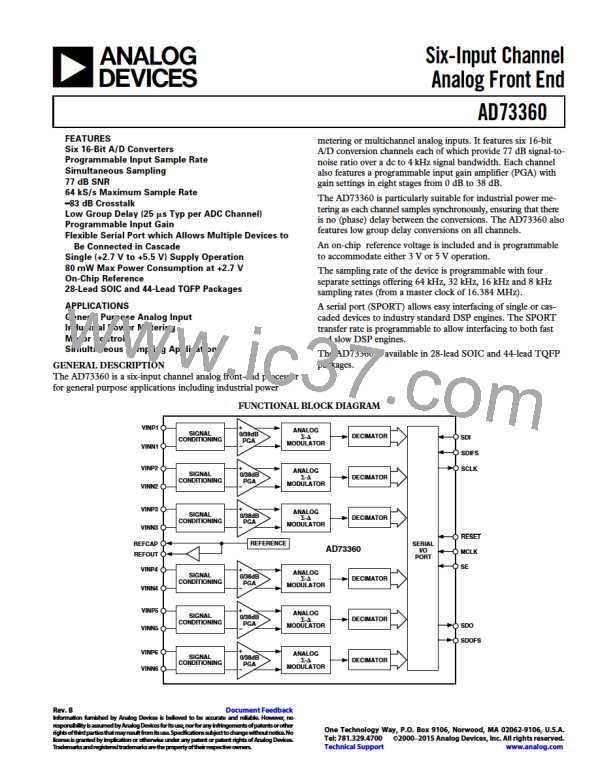AD73360
Cascade Operation
In Cascade Mode, each device must know the number of de-
vices in the cascade to be able to output data at the correct
time. Control Register A contains a 3-bit field (DC0–2) that is
programmed by the DSP during the programming phase. The
default condition is that the field contains 000b, which is equiva-
lent to a single device in cascade (see Table XVIII). However,
for cascade operation this field must contain a binary value that
is one less than the number of devices in the cascade. With a
number of AD73360s in cascade each device takes a turn to
send an ADC result to the DSP. For example, in a cascade of
two devices the data will be output as Device 2-Channel 1,
Device 1-Channel 1, Device 2-Channel 2, Device 1-Channel 2
etc. When the first device in the cascade has transmitted its
channel data there is an additional SCLK period during which
the last device asserts its SDOFS as it begins its transmission of
the next channel. This will not cause a problem for most DSPs
as they count clock edges after a frame sync and hence the
extra bit will be ignored.
The AD73360 has been designed to support up to eight devices
in a cascade connected to a single serial port (see Figure 17).
The SPORT interface protocol has been designed so that device
addressing is built into the packet of information sent to the
device. This allows the cascade to be formed with no extra hard-
ware overhead for control signals or addressing. A cascade can
be formed in either of the two modes previously discussed.
SDIFS
SDI
TFS
DT
MCLK
AD73360
ADSP-2181
DSP
SE
SCLK
DR
SCLK
SDO
DEVICE 1
RESET
RFS
SDOFS
FL0
FL1
SDIFS
SDI
MCLK
When multiple devices are connected in cascade there are also
restrictions concerning which ADC channels can be powered
up. In all cases the cascaded devices must all have the same
channels powered up (i.e., for a cascade of two devices requir-
ing Channels 1 and 2 on Device 1 and Channel 5 on Device 2,
Channels 1, 2 and 5 must be powered up on both devices to
ensure correct operation). Figure 18 shows the timing se-
quence for two devices in cascade.
AD73360
SE
SCLK
SDO
DEVICE 2
RESET
SDOFS
Q0
Q1
D0
D1
74HC74
CLK
Table XVIII. Device Count Settings
DC2
DC1
DC0
Cascade Length
Figure 17. Connection of Two AD73360s Cascaded to
ADSP-2181
0
0
0
0
1
1
1
1
0
0
1
1
0
0
1
1
0
1
0
1
0
1
0
1
1
2
3
4
5
6
7
8
There may be some restrictions in cascade operation due to the
number of devices configured in the cascade and the serial clock
rate chosen. The formula below gives an indication of whether
the combination of sample rate, serial clock and number of
devices can be successfully cascaded. This assumes a directly
coupled frame sync arrangement as shown in Figure 12 and does
not take any interrupt latency into account.
1
fS
6 × [((Device Count − 1) × 16) + 17]
Connection of a cascade of devices to a DSP, as shown in
Figure 17, is no more complicated than connecting a single
device. Instead of connecting the SDO and SDOFS to the
DSP’s Rx port, these are now daisy-chained to the SDI and
SDIFS of the next device in the cascade. The SDO and
SDOFS of the final device in the cascade are connected to the
DSP’s Rx port to complete the cascade. SE and RESET on all
devices are fed from the signals that were synchronized with
the MCLK using the circuit of Figure 19. The SCLK from
only one device need be connected to the DSP’s SCLK input(s)
as all devices will be running at the same SCLK frequency and
phase.
≥
SCLK
When using the indirectly coupled frame sync configuration in
cascaded operation it is necessary to be aware of the restrictions
in sending control word data to all devices in the cascade. The
user should ensure that there is sufficient time for all the control
words to be sent between reading the last ADC sample and the
start of the next sample period.
1
2
3
4
5
6
7
8
9
10 11 12 13 14 15 16
1
2
3
4
5
6
7
8
9
10 11 12 13 14 15 16 17
1
2
3
4
5
6
7
8
DEVICE 1 - CHANNEL 1
DEVICE 2 - CHANNEL 1
DEVICE 2 - CHANNEL 2
Figure 18. Cascade Timing for a Two-Device Cascade
REV. B
–23–

 ADI [ ADI ]
ADI [ ADI ]